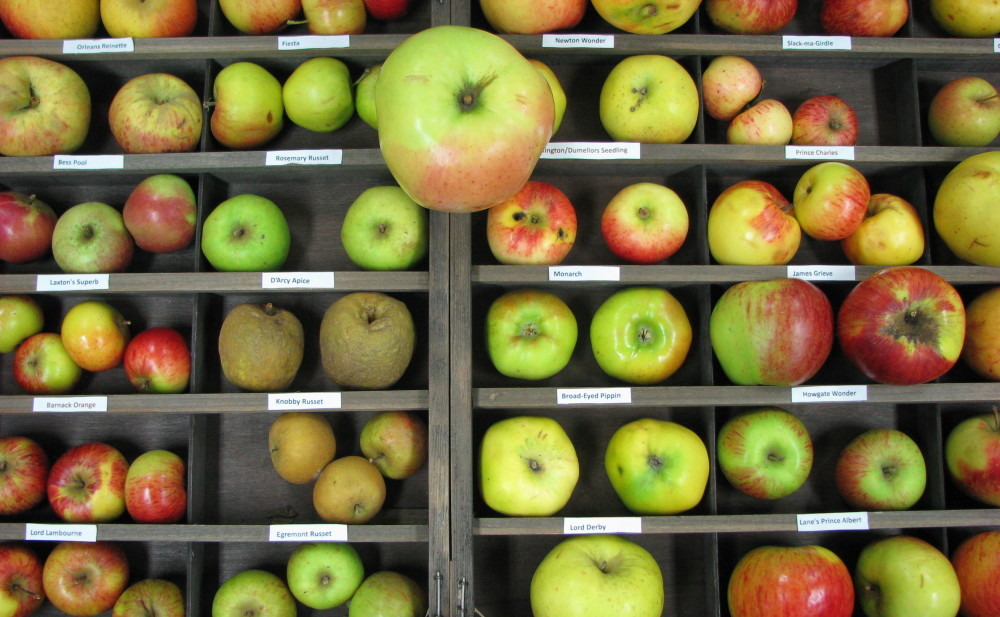Fruit variety identification

Identification is crucial for the conservation of heritage fruit varieties.
Knowing the variety of your fruit can give you information about how the fruit is best used, how long it can be stored, its resistance to disease outbreaks and even how long you can expect the tree to live. It can also give you a bit of history about your orchard and the area in which you live as many varieties have strong connections to the region in which they were raised.
It is no small task to attempt to identify a fruit variety as there are literally thousands of named varieties and many of the distinguishing characters can be obscure or variable. However there are experts in this field that will help you out and some great guides to help you identify them yourself.
Important: if a tree was raised from a pip, it is a new and nameless variety and its fruit should not be sent for identification. These are often found on roadsides or may have been planted intentionally. If you think a new variety is of merit, contact FruitID.com to find out about the Register of Local Cultivars. This will help get it established as a recognised cultivar.
If you want more information about fruit varieties and which are local to your area, visit our page on fruit varieties.
If you already know the varieties of the fruit in your orchard, let us know in the varieties form below
Ask the experts
Most fruit identification is carried out by only a handful of specialists who have accumulated a wealth of knowledge over a life time of experience and interest.
Your Local Orchard Group is a good place to start for finding the right contacts in your area.
The Royal Horticultural Society also hosts special sessions throughout the year where experts are on hand to identify a range of fruit cultivars.
Contact Steve at PTES for email assistance and further information.
Ask the experts – Apple days
There is often an expert available at Apple Days for fruit identification. You will need to:
- At least three good, clean representative samples with stalk and eye intact, and as little insect damage as possible.
- As much historical and contextual information about the tree as you can gather.
- The size of the tree and trunk diameter.
- Additional information that will help the identifier is when the fruit normally ripens, whether the tree crops every year or every other year, when it blossoms, and how long the fruit stores.
Visit our events page for listings.
Sending samples by post
Brogdale Farm is home to the National Fruit Collection. They offer an identification service by post and also an advice/information hotline.
DNA fingerprinting
This method is not without it limits, but for the most part, it is very reliable and able to distinguish between very similar fruits, like closely related apples, most cherries, and many plums. The system works by comparing the DNA profile of a sample to the database of known cultivar profiles. It is quite expensive for a single sample, but gets cheaper the more samples submitted at a time. The cost is however coming down and there is a bulk sampling scheme run by FruitID.com which brings the cost equal to that of the RHS or National Fruit Collection experts (and less when you consider P+P). DNA testing is done by NIAB East Malling Research.
Identify varieties yourself
Courses
If you are interested in learning some identification skills for yourself, there are a small number of fruit identification workshops available through Local Orchard Groups. Both the Gloucestershire orchard group and the East of England Apples and Orchards Project have previously run courses, so keep an eye out for future events. Marcher Apple Network run weekly apple ID courses from September through to December. Anybody is welcome to sit in – the best way to learn apple identification.
We will aim to keep this list up to date, so if you know of any courses you would like to add, email orchards@ptes.org
Books
For a complete list, see the fruit ID books section of the bibliography.
- The New Book Of Apples (2002) Joan Morgan & Alison Richards, Edbury press
- The Book of Pears: The Definitive History and Guide to over 500 varieties (2015)
Joan Morgan, Edbury Press - Apples: A Field Guide (2015). Michael Clark
- The Apple Book (2014). Rosie Sanders, RHS
- Apples a Guide to the Identification of International Varieties (1983). John Bultitude, Univ of Washington Pr
- Cider Apples: The New Pomona (2014) Liz Copas
- A Somerset Pomona (2001). Liz Copas, Dovecote Press
- Pears (1998). Jim Arbury & Sally Pinhey, Wells & Winter
Online
- Fruit ID.com – the best online resource for apple (plum, cobnut and pears coming soon) identification based on fruit and tree characteristics. The important documentation work being done at FruitID.com has secured the future of hundreds of varieties and helped thought-lost varieties be verifiably reintroduced.
- Gloucestershire Orchard Trust – has excellent information on fruit identification, including two downloadable keys (not specific to Gloucestershire)
- Devon Apples – identification of Devonshire apples
- Fruit Forum – includes a blog for discussing all things fruit related
- Guide to the apple varieties of Somerset – PDF written by Somerset Council (download from PTES website)
- Orange Pippin – includes a discussion forum for varieties
- Garden Apple ID – identification of Isle of Wight apples
